
NGC 12 is an intermediate spiral galaxy in the Pisces constellation. It was discovered by William Herschel on December 6, 1790.

NGC 4666 is a spiral galaxy in the equatorial constellation of Virgo, located at a distance of approximately 55 megalight-years from the Milky Way. It was discovered by the German-born astronomer William Herschel on February 22, 1784. It is a member of the Virgo II Groups, a series of galaxies and galaxy clusters strung out from the southern edge of the Virgo Supercluster. John L. E. Dreyer described it as "bright, very large, much extended 45°±, pretty suddenly brighter middle". It is a member of an interacting system with NGC 4668 and a dwarf galaxy, and belongs to a small group that also includes NGC 4632.
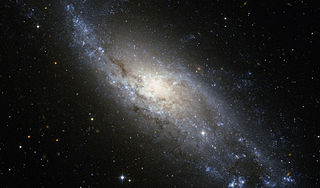
NGC 406 is a spiral galaxy quite similar to the well known Whirlpool Galaxy, located some 65 million light-years away, in the southern constellation of Tucana and discovered in 1834 by John Herschel. It is described in the New General Catalogue as "faint, very large, round, very gradually a little brighter middle". NGC 406 is about 60000 light-years across, roughly half the diameter of the Milky Way.

"Legacy Survey Sky Browser". www.legacysurvey.org. Retrieved 2023-05-19.
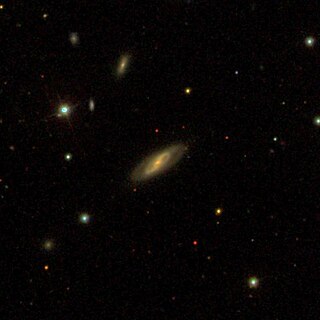
NGC 74 is a lenticular galaxy located in the Andromeda constellation. It was discovered on 7 October 1855 by Irish astronomer William Parsons.

NGC 165 is a barred spiral galaxy located in the constellation Cetus. It was discovered in 1882 by Wilhelm Tempel and was described by as "faint, large, star in centre, eastern of 2" by John Louis Emil Dreyer.

NGC 167 is a spiral galaxy located approximately 172 million light-years from the Solar System in the constellation Cetus. It was discovered in 1886 by Francis Preserved Leavenworth.

NGC 252 is a lenticular galaxy located in the constellation Andromeda. It was discovered by William Herschel in 1786.

NGC 254 is a lenticular galaxy located in the constellation Sculptor. It was discovered by John Herschel in 1834. It is in a galaxy group with NGC 134.

NGC 259 is a spiral galaxy located in the constellation Cetus. It was discovered by William Herschel in 1786.

NGC 3610 is an elliptical galaxy in the constellation Ursa Major. It was discovered on 8 April 1793 by William Herschel.

NGC 397 is a lenticular galaxy located in the constellation Pisces. It was discovered on December 6, 1866 by Robert Ball. It was described by Dreyer as "extremely faint, small, round, very faint star to west."

NGC 398 is a lenticular galaxy located in the constellation Pisces. It was discovered on October 28, 1886 by Guillaume Bigourdan. It was described by Dreyer as "very faint, very small, stellar."

NGC 410 is an elliptical galaxy located in the constellation Pisces. It was discovered on September 12, 1784 by William Herschel. It was described by Dreyer as "pretty bright, pretty large, northeastern of 2.", the other being NGC 407.

NGC 3642 is a spiral galaxy in the constellation Ursa Major. The galaxy has a low-ionization nuclear emission-line region. It is located at a distance of circa 30 million light years from Earth, which, given its apparent dimensions, means that NGC 3642 is about 50,000 light years across. The galaxy is characterised by an outer pseudoring, which was probably formed after the accretion of a gas rich dwarf galaxy.
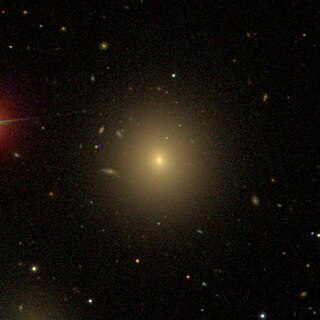
NGC 4458 is an elliptical galaxy located about 54 million light-years away in the constellation of Virgo. It was discovered by astronomer William Herschel on April 12, 1784. NGC 4458 is a member of Markarian's Chain which is part of the Virgo Cluster. It is in a pair with the galaxy NGC 4461. NGC 4458 and NGC 4461 are interacting with each other.
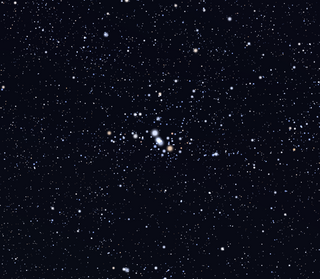
NGC 5281 is an open cluster in the constellation Centaurus. It was discovered by Nicolas Louis de Lacaille in 1751-1752 from South Africa, and catalogued it as Lacaille I.7. NGC 5281 is located three and a quarter degrees southwest of Beta Centauri. Under dark skies, it is bright enough to be spotted with naked eye, appearing as a 6th magnitude star.

NGC 1381 is a lenticular galaxy located in the constellation Fornax. It is located at a distance of about 60 million light years from Earth, which, given its apparent dimensions, means that NGC 1381 is about 55,000 light years across. It is a member of the Fornax Cluster. NGC 1381 appears edge-on and features a thin disk with high surface brightness and a boxy bulge. Both the box-shaped bulge and the kinematics of the central area of the galaxy suggest that NGC 1381 has a bar.
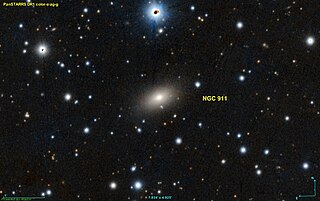
NGC 911 is an elliptical galaxy located in the constellation Andromeda about 258 million light years from the Milky Way. It was discovered by French astronomer Édouard Stephan in 1878. It is a member of the galaxy cluster Abell 347.



















